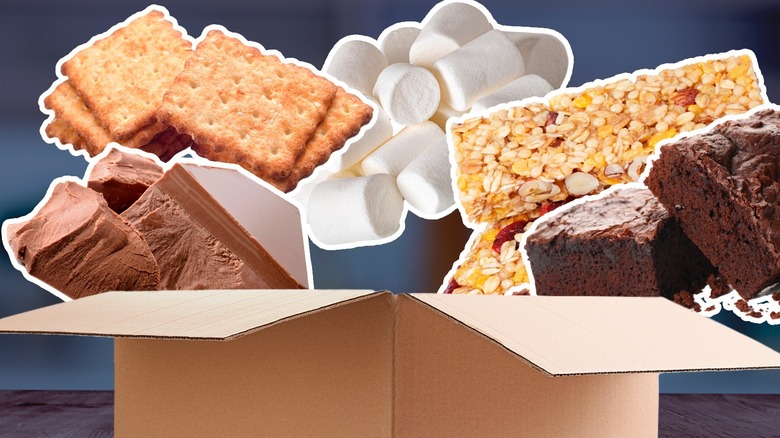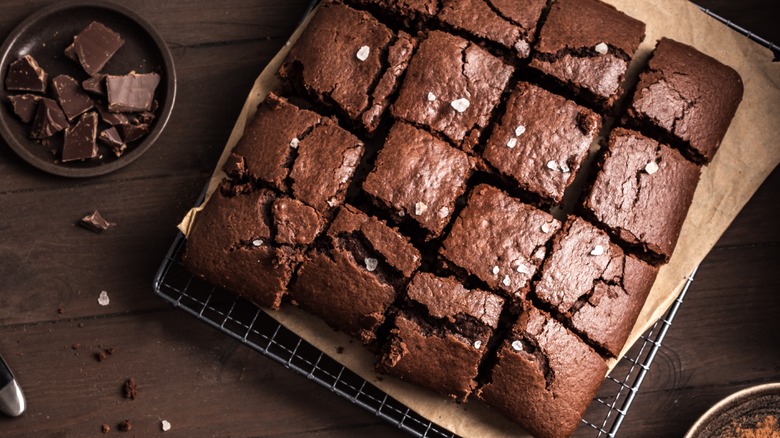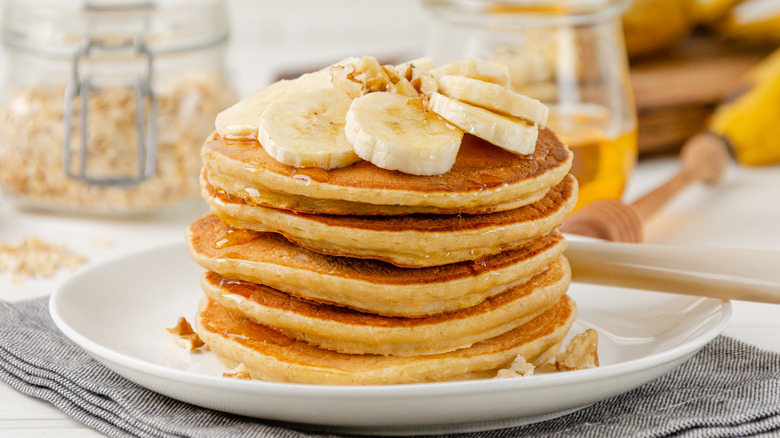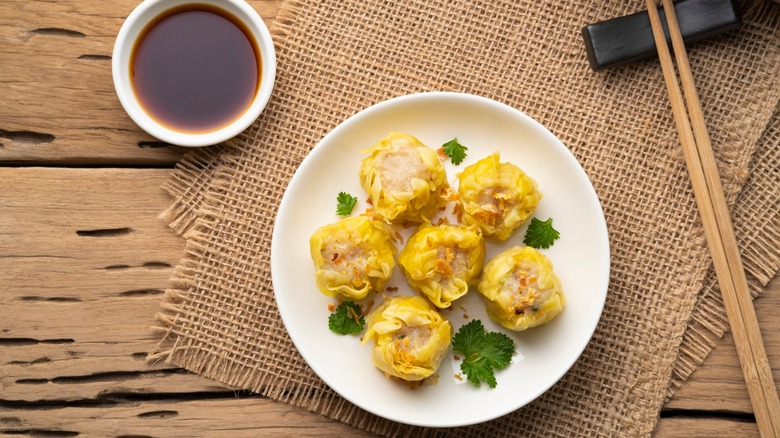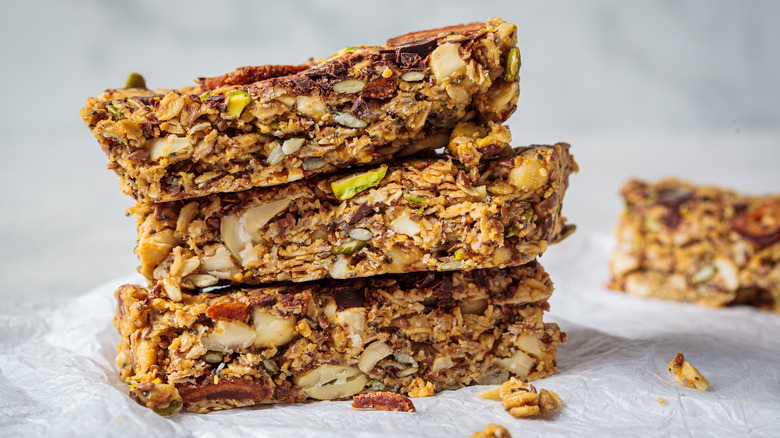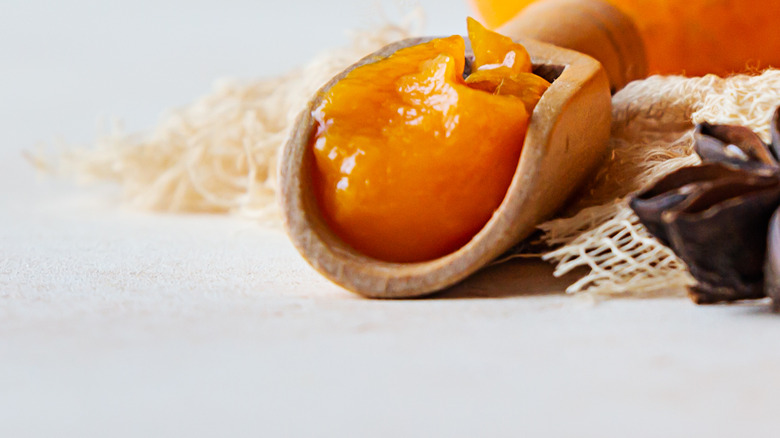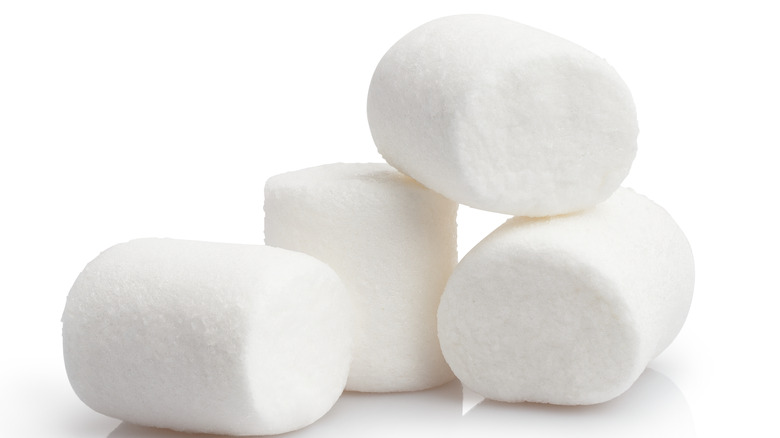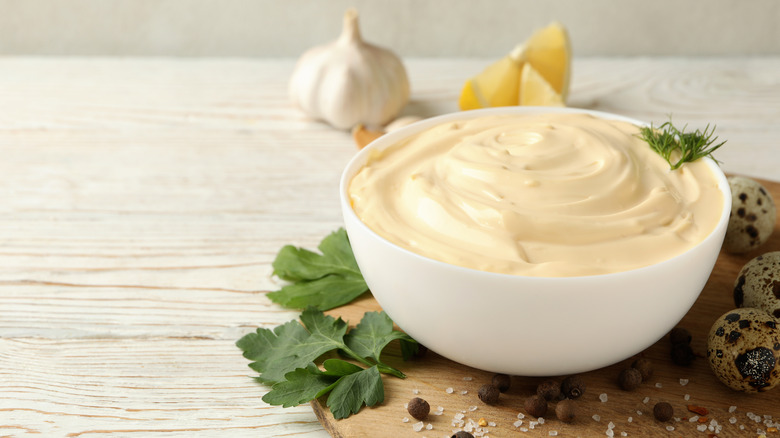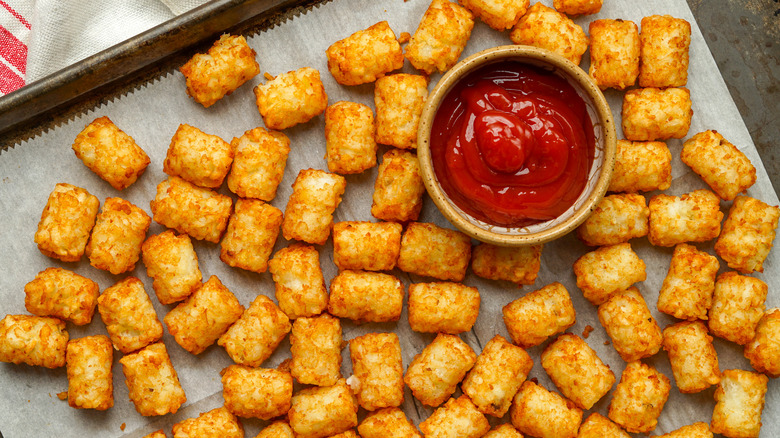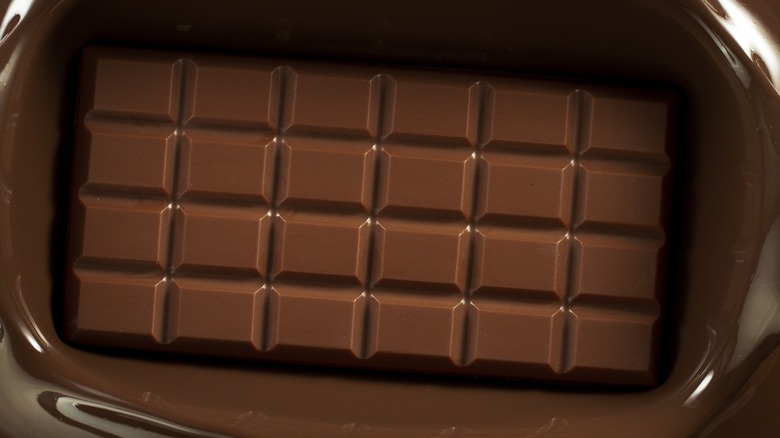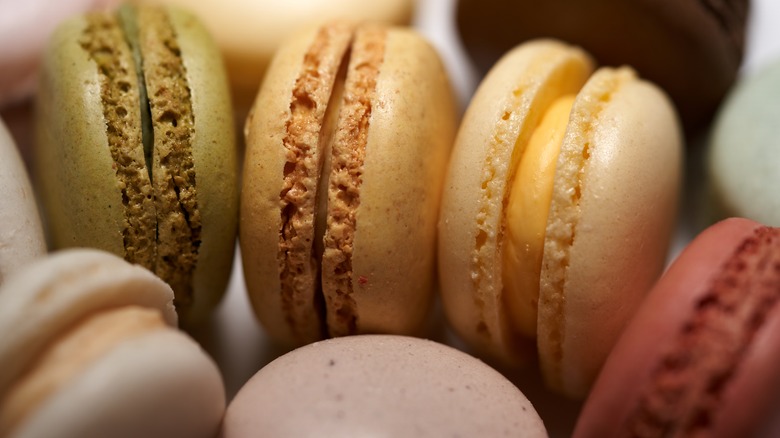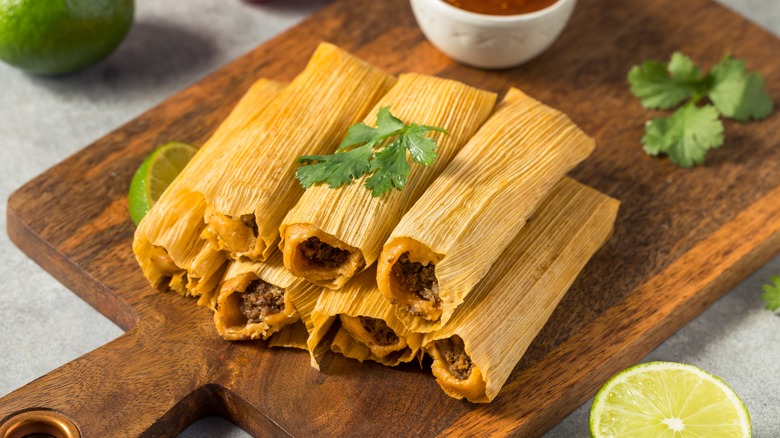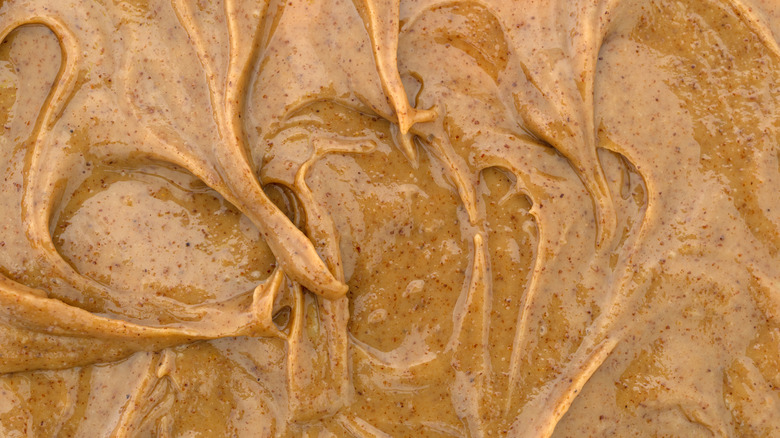14 Foods That Are Better Out Of The Box
There's a certain honor that accompanies a meal made from scratch. The loose bag of flour and soiled countertops? Battle wounds. The hours you spent in the kitchen? A wildly romantic, grand gesture that demonstrates your passion for cooking. And while, for us at least, all time in the kitchen is time well spent, there does come a moment when you realize that — for certain dishes — your efforts may be better spent doing something else. Like, say, unloading the dish rack or trying out one of these kitchen cleaning hacks.
Yes, it's humbling to admit that a premade, mass-produced mixture or food product knows a trick that you do not, but that knowledge can also be liberating. So instead of toiling over that batch of croissants that takes three days or dirtying the food processor in a well-intentioned but messy endeavor for aioli, allow us to give you the permission to throw in the towel and take the easy, just-as-delicious road with these foods that are better out of the box. We won't stop you from taking credit for how tasty they are, and no one else needs to know exactly how it all came together. Your secret is safe with us.
Brownies
Many professional bakers and home cooks swear by the Ghirardelli boxed brownie mix as a superior choice to scratch-made brownies — and we understand why. These brownies are so great that we bet anyone you feed them to will assume that they're homemade. They strike a remarkable, near-impossible balance of being both chewy and fudgy, with a rich, sophisticated flavor that can be attributed to Ghirardelli's tradition of sourcing high-quality, gourmet chocolate. The skin is crinkly, thin, and almost crispy, while the interior remains dense and doughy, resulting in a brownie that melts in your mouth and ends up getting devoured extremely quickly.
Want to add a bit of personal flair to the batch? Sprinkle in some butterscotch chips, add a swirl of peanut butter, or sub out water with brewed coffee if you're a fiend for java flavors. If you can't find Ghirardelli for some reason, other choice brownie mixes include selections from Miss Jones Baking Co, King Arthur Baking Company, and the protein-packed ones from Kodiak Cakes.
Pancake mix
The doughy aroma of pancake batter sizzling on an oil-soaked frying pan is intoxicating enough to wake even the sleepiest of night owls and party animals on a Sunday morning. So why not make this delightful hypothetical an easy reality by cutting out several rounds of whisking, sifting, and measuring? With a good box of pancake mix, you're basically getting a streamlined mixture of what you would normally have to mix together by hand: flour, sugar, baking powder, and salt, plus a few other additions that help optimize the pancake's texture and flavor.
What's more, you can always try one of these simple upgrades to boxed pancake mix, such as using milk rather than water or infusing a few drops of vanilla extract, to level up your breakfast (or lunch, or dinner, we're not judging) even more. Stick the landing on your simplified pancake prep by avoiding these 14 mistakes everyone makes when cooking pancakes. And do yourself a favor by using genuine maple syrup, rather than that terrifying, high fructose corn syrup concoction people call pancake syrup.
Croissants
If you have ever pursued the valiant mission of homemade croissants, you probably had a few major takeaways. For one, laminated dough — also known as puff pastry — is no joke. The process can take up to three days and involves making dough, beating several sticks of butter into the shape of a rectangle, and then chilling, turning, and folding said dough and butter block several times. Once that's complete, then you make the actual croissants, a process that includes shaping, several hours of subsequent proofing, and then, finally, baking them in the oven.
Honestly, when you add up the length of time and skill required to knock out the entire process, we're surprised these French delicacies don't cost upwards of $10 per pastry (though we are certainly not complaining). But take solace, readers, as there is a better way to make fresh croissants that involves neither days of labor nor a visit to the bakery. Enter Trader Joe's frozen croissants, which take you nearly all the way to the finish line of this lengthy, complicated baking process. All you have to do is take these frozen, pre-shaped beauties out of the box and let them proof on your countertop overnight. The next morning (or afternoon), pop them in the oven for about 20 minutes, and, voilà, chow down on the French breakfast of your dreams.
Crackers
We totally get the appeal of making your own crackers. It sounds like a cute and frugal baking project — and plenty of online blogs boast about having "simple" five-minute recipes — but in this case, it's better to leave these crispy concoctions to the professionals. Unlike your home kitchen and possibly-warped baking sheets, the precision-focused nature of a factory or production facility is perfectly suited to roll, size, and bake crackers at their most optimal shape and temperature. Factories even have unique drying, heating, and air circulation systems that are basically impossible to replicate in a home oven.
We have to give it to the robots here; they are better suited for this type of production. Plus, it's not like crackers are expensive. After it is all said and done, you would maybe save a few dollars maximum, and, frankly, they would probably taste worse than their store-bought, lab-tested counterparts. We recommend saving your efforts for a more worthwhile pursuit like, say, one of these excellent party dips.
Dumplings
Homemade dumplings are a magical thing. In the mood for a fun kitchen experience? Please do try making these at home, because once you've readied the wrappers and filling, it truly is a meditative, peaceful process. As you slowly but surely wrap each and every doughy parcel, an hour (or maybe two) tends to fly by, especially if you've got the proper tunes and company by your side.
But while it is a lovely ritual, let's be real: Most people don't have time on a weeknight. And, as luck would have it, dumplings freeze incredibly well, meaning they will likely taste just as good (if not better) when reheated from a freezer. Just keep in mind that not all frozen dumplings are created equal, so you may want to check out our guide to the frozen dumplings you should buy at the grocery store before stocking up on a ton of bags.
Granola bars
The reputation of granola bars has (rightfully) plummeted over the last few decades due to many of them more closely resembling candy bars more than meal replacements. And with that shift in public sentiment has come the advent of the DIY granola bar trend. Personally, though, we are not so convinced that making granola bars at home is the best way to go.
There's simply too much that can go wrong, too many dishes to clean, and far too many opportunities for tiny granola crumbs to spread in every crevice of your kitchen. A few common mistakes include everything from using the wrong oil and temperature to storing the cooked granola improperly. It's also easy to use too much or too little sweetener or select an ill-suited combination of ingredients. Not to mention, isn't the whole point of eating a granola bar convenience? Sure, there are plenty of nutritionally-lacking granola bars out there that are worth avoiding, but there are also plenty of quality granola bar choices in the modern marketplace that are as delicious as they are easy to obtain.
Canned pumpkin
There's no glory in homemade pumpkin purée. Internet blogs may preach that "it's so worth it" to make your own — or that it's not difficult at all — but we're frankly skeptical of those claims. For those of you who have never subjected yourself to this project, the process takes more than an hour and includes cutting open a pumpkin, scraping out its guts, roasting for about an hour, peeling off the pumpkin skin, and then scraping the mixture into a food processor.
Maybe if after all of that effort, say, a cake or a bagel appeared, then the process would be worth it. But after all of that work, all you get is a bowl of orange mush, which you then need to use in another recipe. Plus, most bakers agree that the canned stuff actually has a better texture and flavor — not to mention, it's also cost-effective and generally more reliable when it comes to baking recipes.
Marshmallows
Not to be a killjoy, but there are a wide world of things that can go horribly wrong when you are making these cloud-like confections at home. For instance, it is not unheard of for batches of homemade stuff to turn out soggy, mushy, souplike, or with an otherwise unpleasant texture. And the culprit of such an undesirable form could be anything from under-whipping in humid weather to an improperly calibrated candy thermometer.
Temperature and ruinous humidity aside, the process for homemade marshmallows takes many hours, with recipes ranging from a six-hour cure time to upwards of 24 hours. So if you did mess up at any point, you likely won't realize the error of your ways until it's far too late. Take it from us that such a revelation is a devastating feeling. All that to say, we recommend opting for a simpler, more reliable store-bought marshmallow option.
Mayonnaise
If the spirit compels you, we're not saying that homemade mayonnaise is a bad idea. The process is a great lesson in emulsification — a special chemical process that whisks together two typically contrarian ingredients of oil and vinegar.
We'll level with you, though: That emulsification doesn't always come easy. It requires a steady, strong hand to whisk the oil and vinegar together, and if you don't get the ratios or timing right, your mayonnaise could end up lumpy or separated. Moreover, store-bought mayo has a longer shelf life, so you can keep it in your fridge longer without worrying about it going bad.
That being said, not all mayonnaise is made equal. We recommend opting for the Southern staple Duke's Mayonnaise. Known for its creamy and tangy taste, Duke's doesn't contain any added sugars or preservatives, giving it a pure, unadulterated taste with the perfect level of piquant twang.
Tater tots
In our book, there is no good reason to attempt scratch-made tater tots. It's a messy, time-consuming process that includes tons of peeling, shredding, shaping, and frying — which is a heck of a hassle for a food item that you can find for a few bucks at many food establishments. In fact, the process is so tiresome that many chefs opt to serve frozen tater tots in their restaurants rather than reinvent the wheel in their own kitchens. And if it's good enough for chefs, it's good enough for us.
Tater tots are also famously a product that's readily available in the frozen aisle of any grocery store. And once you have got a bag secured, you can either fry them or bake them for delicious results. If you really want to take your tater tot devotion to a new level, we recommend using them as an ingredient in a fun recipe like this cheesy tater tots dish or the iconic tater tot casserole.
Chocolate
Fancy yourself a homegrown Willy Wonka? You may want to think again unless you have plenty of patience, access to raw cacao pods, and a special melanger device. If you're curious, the melanger is essentially a mechanical grindstone that helps transform ground cacao into its smooth, velvety, and less acidic final form.
Melanger aside, the chocolate-making process is undeniably complex, lasting at least a week with steps that include fermentation, roasting, grinding, and tempering. In all, for most folks (beyond the uber-dedicated) this elongated process is simply not worth the effort.
Want the thrill of feeling like a chocolatier without going fully overboard? You may want to consider the more straightforward chocolate truffle. As you probably know, there are also plenty of incredible high-quality chocolate bars available at most grocery stores, which is far simpler than the process of tracking down raw cacao pods and a melanger. Some of our favorite chocolate brands are Lindt, Ferrero Rocher, and Ghirardelli.
Macarons
Heed our warning: If you see a recipe online that claims it has the key to an "easy" macaron recipe, take that with a very large grain of salt. Macarons are notoriously finicky to make from scratch. The process involves whipping egg whites to perfection, carefully folding in almond flour and sugar, piping the batter onto a baking sheet, and baking them to just the right level of chewiness.
Sadly, one small misstep can lead to disastrous results, such as flat or cracked macarons that don't have the characteristic domed shape and chewy texture. And even small details such as humidity can make or break the outcome of this delicate, decadent pastry.
While tracking down a quality box is not always easy, Trader Joe's is known to offer enticing, reliable boxes of this dreamy treat — and, according to TJ's, these treats are actually shipped all the way over from France. If you're willing to splurge, the French bakery Pierre Hermé also ships boxes of macarons across the world.
Tamales
Much like dumplings, tamales are a beloved tradition, but they are also an extremely time-consuming and labor-intensive process to make. This Mexican dish typically takes around six hours to craft (if not a bit more), which includes preparing the filling, making the masa, assembling the tamales, and then steaming them to perfection. If you're unfamiliar or new to the process, making tamales from scratch can be especially daunting.
Honestly, rather than heading immediately to the grocery store, our first recommendation would be to see if there are any tamalerias nearby, as that's where you'll find the absolute best product. But if you're craving the comfort of this humble, soulful dish — and don't have a knowledgeable group around you to help with the process — your best bet on quality tamales is definitely a store-bought option. Some of our favorites include the ones from Trader Joe's, Del Real Foods, and H-E-B.
Nut butter
Unless you have a truly top-of-the-line food processor, it's probably not worth making your own nut butter. While making nut butter from scratch may sound appealing and easy enough, it can actually be more time-consuming than you'd expect. Not to mention, the residual butter leaves a sticky, tough-to-clean residue all over the blade and food processor receptacle. File that under one of those dishes we let soak for far too long.
The really difficult nut to crack (sorry, we had to) is the texture. Without professional-grade equipment, you can grind all you want and you likely won't reach that silky, gentle texture that is so easy to find in the grocery store aisle. Not to mention, the homemade version is far less shelf stable, which means you won't be able to pull a Ted Lasso and permanently leave your jar of nut butter open on your counter for easy access.
